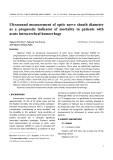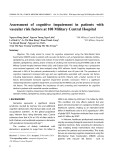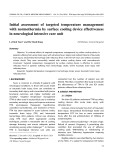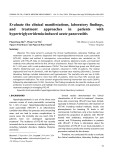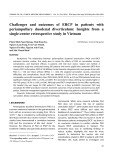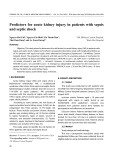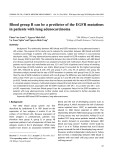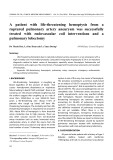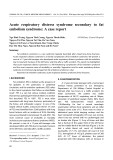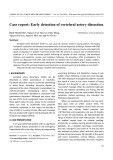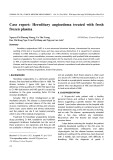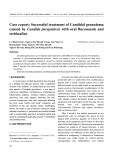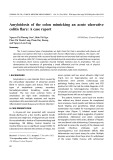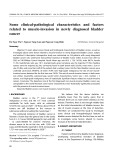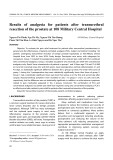Sumoylation of a meiosis-specific RecA homolog, Lim15/Dmc1, via interaction with the small ubiquitin- related modifier (SUMO)-conjugating enzyme Ubc9 Akiyo Koshiyama, Fumika N. Hamada, Satoshi H. Namekawa, Kazuki Iwabata, Hiroko Sugawara, Aiko Sakamoto, Takashi Ishizaki and Kengo Sakaguchi
Department of Applied Biological Science, Tokyo University of Science, Chiba-ken, Japan
Keywords sumoylation; RecA; meiotic recombination; Coprinus cinereus; post-translational modification
Correspondence K. Sakaguchi, Department of Applied Biological Science, Tokyo University of Science, 2641 Yamazaki, Noda-shi, Chiba-ken 278-8510, Japan Fax: +81 471 23 9767 Tel. +81 471 24 1501 (ext. 3409) E-mail: kengo@rs.noda.tus.ac.jp
(Received 25 April 2006, revised 29 June 2006, accepted 3 July 2006)
doi:10.1111/j.1742-4658.2006.05403.x
Sumoylation is a post-translational modification system that covalently attaches the small ubiquitin-related modifier (SUMO) to target proteins. Ubc9 is required as the E2-type enzyme for SUMO-1 conjugation to tar- gets. Here, we show that Ubc9 interacts with the meiosis-specific RecA homolog, Lim15 ⁄ Dmc1 in the basidiomycete Coprinus cinereus (CcLim15), and mediates sumoylation of CcLim15 during meiosis. In vitro protein–pro- tein interaction assays revealed that CcUbc9 interacts with CcLim15 and binds to the C-terminus (amino acids 105–347) of CcLim15, which includes the ATPase domain. Immunocytochemistry demonstrates that CcUbc9 and CcLim15 colocalize in the nuclei from the leptotene stage to the early pach- ytene stage during meiotic prophase I. Coimmunoprecipitation experiments indicate that CcUbc9 interacts with CcLim15 in vivo during meiotic pro- phase I. Furthermore, we show that CcLim15 is a target protein of sumoy- lation both in vivo and in vitro, and identify the C-terminus (amino acids 105–347) of CcLim15 as the site of sumoylation in vitro. These results sug- gest that sumoylation is a candidate modulator of meiotic recombination via interaction between Ubc9 and Lim15 ⁄ Dmc1.
property of each protein. Therefore, sumoylation seems to be involved in the regulation of protein function. Consistent with these views, sumoylation has crucial roles in many different biological processes, including protein localization and stability, transcriptional activit- ies, and the regulation of gene expression [7].
We found a novel
Sumoylation is the post-translational protein modifica- tion system by which the small ubiquitin-related modi- fier (SUMO) binds covalently to target proteins. The sumoylation pathway is analogous to that of ubiquiti- nation, including similar enzymes such as SUMO-acti- vating enzyme (E1) and SUMO-conjugating enzyme (E2). Unlike ubiquitination, however, sumoylation has only one E2-type enzyme, Ubc9 [1–4]. Following acti- vation of SUMO-1 by the E1-activating enzyme, Ubc9 conjugates the active form of SUMO-1 to target pro- teins in vitro [5].
Previous reports postulate two pivotal roles for Ubc9- mediated sumoylation. First, sumoylation contributes to the stability of target proteins by antagonizing ubi- quitin-mediated degradation [6]. Second, sumoylation affects the function of substrates, which depend on the
interaction between Ubc9 and meiosis-specific RecA homolog Lim15 ⁄ Dmc1 in the basidiomycete Coprinus cinereus (CcLim15) through a yeast two-hybrid screening using CcLim15 as bait. In eukaryotes, Lim15 ⁄ Dmc1 and Rad51 have been identi- fied as RecA homologs. Whereas Rad51 is required in meiotic recombination, mitotic recombination and DNA repair, Lim15 ⁄ Dmc1 is known as a specific fac- tor for meiotic recombination [8]. Recent studies have shown that Rad51 interacts with various nuclear
Abbreviations DAPI, 4¢,6-diamidino-2-phenylindole dihydrochloride n-hydrate; GST, glutathione S-transferase; SUMO, small ubiquitin-related modifier.
FEBS Journal 273 (2006) 4003–4012 ª 2006 The Authors Journal compilation ª 2006 FEBS
4003
A. Koshiyama et al.
Lim15 ⁄ Dmc1 is a novel sumoylation target protein
number AB113652). The CcUbc9 protein showed 75.8% sequence identity with Saccharomyces pombe Ubc9 ⁄ Hus5, 59.7% sequence identity with Saccharo- myces cerevisiae Ubc9, 73.2% sequence identity with human Ubc9, 71.9% sequence identity with Drosophila melanogaster Ubc9 and 66.7% sequence identity with Arabidopsis thaliana Ubc9.
further
To confirm the specificity of the interaction between full-length CcUbc9 cDNA CcUbc9 and CcLim15, was subcloned in-frame into the pGADT7 vector and used as bait with pGBKT7–CcLim15. Only yeast cells cotransformed with both pGADT7–CcUbc9 and pGBKT7–CcLim15 grew on selective medium (Fig. 1A). Consistent with this, histidine and adenine prototrophy and galactosidase activity were observed in yeast expressing both CcUbc9 and CcLim15 (Fig. 1B). These results confirmed a specific interaction between CcUbc9 and CcLim15 in the yeast two-hybrid system.
CcUbc9 interacts with CcLim15 in vitro
proteins such as RP-A [9], Rad52 [10], Rad54 [11], BRCA2 [12] and the Rad55–Rad57 heterodimer [13]. By contrast, Lim15 ⁄ Dmc1-interacting proteins are less well known. The Rad54 homolog protein, Rdh54 ⁄ interacts with both Rad51 and Lim15 ⁄ Dmc1 Tid1, [14]. Meiosis-specific proteins Mei5 and Sae3 form a ternary complex with Lim15 ⁄ Dmc1 [15,16]. Recently, Hop2–Mnd1 complex [17] and DNA topoisomerase II [18] were reported to be novel binding partners for Lim15 ⁄ Dmc1. Given the meiosis-specific role of Lim15 ⁄ Dmc1, screening for Lim15 ⁄ Dmc1 interactors would shed light on the mechanistic aspect of meiotic recombination. This concept prompted us to screen for such proteins using the yeast two-hybrid system. The basidiomycete C. cinereus has been used as a genetic tool for mating type and sexual develop- ment genes [19–21] and is well suited to such studies on meiosis because of its synchronous meiotic cell cycle in the fruiting cap. Meiotic prophase I is partic- ularly synchronous [22,23]. As reported previously, we succeeded in cloning the gene for C. cinereus Lim15 ⁄ Dmc1 (CcLim15) [24]. We found that CcLim15 expression is restricted to meiotic prophase I [24,25]. Because C. cinereus can be induced to synchronously enter the meiotic cell cycle upon exposure to light, we were able to specifically construct a meiotic prophase I stage cDNA library.
to the
To verify the interaction between CcUbc9 and CcLim15, we performed a glutathione S-transferase (GST) fusion pull-down assay with purified GST– CcUbc9 fusion protein and His- and T7-tagged full- length CcLim15. His–T7–CcLim15 coprecipitated with GST–CcUbc9, as detected by western blot with anti- CcLim15 IgG (Fig. 2A). Conversely, we performed an in vitro anti-(T7 tag) mAb immunoprecipitation assay using purified His–T7–CcLim15 and GST–CcUbc9. GST–CcUbc9 coprecipitated with His–T7–CcLim15 as detected by western blot using anti-CcUbc9 IgG (Fig. 2B).
In this study we characterize the novel interaction between Ubc9 and Lim15 ⁄ Dmc1. Furthermore, we demonstrate that CcLim15 is a target protein of sum- oylation both in vivo and in vitro. These results give clarity recombination controlling meiotic through post-translational modifications such as sum- oylation.
Results
Identification of the novel interaction between CcUbc9 and CcLim15 using a yeast two-hybrid system
but
To identify factors that interact with CcLim15, we per- formed a yeast two-hybrid screen with CcLim15 as bait. The library was screened twice and 1.2 · 106 clones were analyzed. More than 500 candidates were His+, Ade+, and LacZ+ clones. Five of 150 sequenced cDNAs encoded the Ubc9 homolog. We isolated the full-length cDNA of this gene (477 bp) and named it C. cinereus Ubc9 (CcUbc9). The ORF of CcUbc9 encoded a predicted product of 158 amino acid residues with a molecular mass of 18 kDa. The molecular sequence data reported here appear in the (Accession DDBJ nucleotide
sequence databases
Lim15 ⁄ Dmc1 is divided into two functional domains. The N-terminal part (amino acids 36–104 in CcLim15) is required for both ssDNA and dsDNA binding, whereas the C-terminal part (amino acids 105–327 in CcLim15) contains an ATPase domain that is conserved with prokaryotic RecA [26,27]. To determine which domain is responsible for binding to CcUbc9, we per- formed GST pull-down assays in the presence of His- tagged CcLim15N protein (amino acids 1–104) (His– CcLim15N) and His-tagged CcLim15C protein (amino acids 105–347) (His–CcLim15C). The GST–CcUbc9 protein efficiently pulled down the His–CcLim15C pro- tein, but not the His–CcLim15N protein (Fig. 2C, left). We also performed reciprocal GST fusion pull-down assays using purified GST–CcLim15N, GST–CcLim15C and His–CcUbc9. His–CcUbc9 coprecipitated with not with GST–CcLim15N GST–CcLim15C, (Fig. 2C, right). These results show that the C-terminus of CcLim15 is required for interaction with CcUbc9.
FEBS Journal 273 (2006) 4003–4012 ª 2006 The Authors Journal compilation ª 2006 FEBS
4004
A. Koshiyama et al.
Lim15 ⁄ Dmc1 is a novel sumoylation target protein
A
B
Fig. 1. CcUbc9 and CcLim15 interact in the yeast two-hybrid system. (A) The indicated plasmid pairs were cotransformed into the AH109 yeast strain. Transformants were plated on selective medium lacking adenine, histidine, leucine, and tryptophan (SD ⁄ -Ade ⁄ -His ⁄ -Leu ⁄ -Trp). The interaction between p53 and the simian virus 40 T anti- gen was used as a positive control. Lamin C and the simian virus 40 T antigen were used as a negative control. (B) Histidine and aden- ine prototrophy and galactosidase activity assay. Colonies grown in SD ⁄ -Leu ⁄ -Trp were replated on SD ⁄ -Ade ⁄ -His ⁄ -Leu ⁄ -Trp with X-a-Gal as the substrate for galactosi- dase.
Nuclear localization of CcUbc9 and CcLim15 during the meiotic cell cycle
analysis that showed ubiquitous expression of CcUbc9 during the meiotic cell cycle (data not shown). Nota- bly, CcUbc9 and CcLim15 partially colocalize in the nuclei from the leptotene stage to the early pachytene stage (Fig. 3N,O, indicated by arrows). This result raised the possibility that CcUbc9 interacts with CcLim15 in vivo during these stages.
In vivo interaction between CcUbc9 and CcLim15 and in vivo sumoylation of CcLim15
the
early pachytene
culminated at
We determined whether interaction between CcUbc9 and CcLim15 occurs in vivo during the stages described above. We performed coimmunoprecipita- tion experiments using crude extract of meiotic tissue in prophase I (Fig. 4). We incubated the crude extract with anti-CcLim15 IgG beads, anti-CcUbc9 IgG beads or preimmune rabbit sera beads. Eluted fractions were analyzed by western blot using anti-CcLim15 IgG. A 37 kDa component, which corresponds to full-length CcLim15, was coprecipitated specifically with the anti-CcUbc9 IgG beads (Fig. 4A, lane 2, lower band), indicating that CcUbc9 interacts with CcLim15 in vivo during meiotic prophase I.
The above results prompted us to examine the cellular localization of CcUbc9 and CcLim15 during the mei- otic cell cycle by immunostaining. According to Lu & Jeng [28], the premeiotic S phase occurs before the onset of karyogamy in C. cinereus. It takes 8 h under control conditions (25 (cid:2)C with a 16 h light ⁄ 8 h dark regime). Meiotic prophase I after karyogamy is classi- fied by five stages: leptotene, zygotene, pachytene, di- plotene, and diakinesis. The leptotene ⁄ zygotene stage, when homologous chromosomes start to align, occurs several hours after karyogamy. The pachytene stage, when homologous chromosomes fully synapse, culmin- ates about 6 h after karyogamy, which is then followed by metaphase I stage. As described previously [18], the CcLim15 signal was distributed on the chromosome in the nuclei from the leptotene to the early pachytene stages (Fig. 3F,G), and the intensity of the CcLim15 signal stage the (Fig. 3G). The CcLim15 signal disappeared after the pachytene stage (Fig. 3H). However, the CcUbc9 sig- nal was detected on the nuclei during the premeiotic S phase and throughout the meiotic cell cycle (Fig. 3I– L). This observation was consistent with northern
Furthermore, we detected another band at 47 kDa in crude extract with anti-CcLim15 IgG (Fig. 4A,
FEBS Journal 273 (2006) 4003–4012 ª 2006 The Authors Journal compilation ª 2006 FEBS
4005
A. Koshiyama et al.
Lim15 ⁄ Dmc1 is a novel sumoylation target protein
B
A
C
Fig. 2. In vitro protein–protein interaction between CcUbc9 and CcLim15. (A) 0.2 nmol His–T7–CcLim15 and glutathione–Sepharose beads were incubated with 0.2 nmol of GST alone (lane 2) or GST–CcUbc9 (lane 3). After washing the beads, bound proteins were eluted and ana- lyzed by western blot using anti-CcLim15 (upper) and anti-(GST tag) (lower) IgGs. (B) 0.2 nmol His–T7–CcLim15 and GST–CcUbc9 were immunoprecipitated with anti (T7 tag) mAb (lane 3). No protein was incubated with GST–CcUbc9 as a negative control (lane 2). Bound proteins were detected by western blot with anti-CcUbc9 (upper) and anti-CcLim15 (lower) IgGs. (C) GST pull-down assays were performed in (A) using GST (lane 2, 5, 8), GST–CcUbc9 (lane 3, 6), GST–CcLim15N (lane 9) or GST–CcLim15C (lane 10) with His–CcLim15N (lane 2, 3), His–CcLim15C (lane 5, 6) or His–CcUbc9 (lane 8–10). After washing the beads, bound proteins were eluted and analyzed by western blot using anti-CcLim15 (left) or anti-CcUbc9 (right) IgG. The asterisk indicates nonspecific cross-reactivity with anti-CcLim15 IgG.
assay, His–T7–CcLim15 was incubated with E1-activa- ting enzyme, E2-conjugating enzyme (Ubc9), SUMO-1, and ATP (see Experimental procedures). We detected sumoylated His–T7–CcLim15 in both mono- and multi-sumoylated forms (Fig. 5A). This result confirms that CcLim15 protein is also a target protein of sum- oylation in vitro.
upper band). Ubc9 is known to interact with various proteins in yeast two-hybrid assays and some of them are confirmed sumoylation targets [29]. The interaction between CcUbc9 and CcLim15 suggests that CcLim15 could be a novel target protein of sumoylation. To test whether the 47 kDa protein is the sumoylated form of CcLim15, we reprobed the membrane with anti- SUMO-1 IgG after removing the anti-CcLim15 IgG. The 47 kDa band contained the sumoylated form of CcLim15 (Fig. 4B, lane 1) and also specifically copre- cipitated with anti-CcUbc9 IgG (Fig. 4A,B, lane 2). This result suggests that CcLim15 is a novel sumoyla- tion target protein via interaction with CcUbc9 in vivo.
tool
CcLim15 is a novel target protein of sumoylation in vitro
To further characterize the sumoylation of CcLim15, we performed in vitro sumoylation assays using bacte- rially expressed and purified CcLim15 proteins. In this
Most SUMO target proteins have a consensus motif -Y-K-X-E ⁄ D-, where Y is a large hydrophobic amino acid and X is any amino acid [30,31]. The lysine resi- due within such a consensus is conjugated to SUMO-1 in the sumoylation pathway. We therefore searched for the consensus motif in CcLim15 using the sumoplot (http://www.abgent.com/doc/sumoplot). analysis As expected, CcLim15 contained two such motifs: one centered on Lys78 (-AKVE-) and another centered on Lys223 (-DKDF-) (Fig. 5B). The motif surrounding Lys78 most closely matched the SUMO consensus motif, although the motif encompassing Lys223 also seemed to be a probable candidate. To examine these
FEBS Journal 273 (2006) 4003–4012 ª 2006 The Authors Journal compilation ª 2006 FEBS
4006
A. Koshiyama et al.
Lim15 ⁄ Dmc1 is a novel sumoylation target protein
A
M
E
I
N
F
B
J
K
O
C
G
P
D
H
L
R
Q
Fig. 3. Nuclear localization of CcUbc9 and CcLim15 in C. cinereus meiotic cells. C. cinereus nuclei at various stages of mei- osis were stained with DAPI (A–D), anti- CcLim15 (green) (E–H), and anti-CcUbc9 (red) (I–L), respectively. The green and red signals were merged in the right panel (yellow) (M–P). Arrows indicate colocalized foci of CcUbc9 and CcLim15. Each stage of the meiotic cell cycle is labeled on the left. Cells were obtained in premeiotic S phase at 6 h before karyogamy, in the lepto- tene ⁄ zygotene stage 3 h after karyogamy, in the early pachytene stage 6 h after karyo- gamy, and in the metaphase I stage 8 h after karyogamy. Scale bar, 1 lm. No signifi- cant staining was detectable with the preim- mune sera (Q, R). Secondary antibodies did not cross-react with the meiotic tissues (data not shown) or with other primary anti- bodies (data not shown).
A
B
Fig. 4. In vivo interaction between CcUbc9 and CcLim15, and in vivo sumoylation of CcLim15.Coimmunoprecipitation experiments using crude extract of meiotic tissue at prophase I. Crude extract (5 mg) was incubated with anti-CcLim15 IgG (lane 1), anti-CcUbc9 IgG (lane 2), or control rabbit serum-conjugated beads (lane 3). After washing the beads, the eluted fractions were analyzed by western blot using anti- CcLim15 IgG (A) or anti-(SUMO-1) IgG (B). Asterisks indicate rabbit IgG.
possibilities, we mutated Lys78 or Lys223 to arginine (His–T7–K78R and His–T7–K223R, respectively). Both single mutants were modified by SUMO-1 in vitro
(Fig. 5B). Although we could not identify the sumoyl- ated lysine, these results imply that there are multiple sumoylation sites in CcLim15.
FEBS Journal 273 (2006) 4003–4012 ª 2006 The Authors Journal compilation ª 2006 FEBS
4007
A. Koshiyama et al.
Lim15 ⁄ Dmc1 is a novel sumoylation target protein
A
C
B
D
(A), mutated CcLim15 proteins (His–T7–K78R or His–T7–K223R)
In vitro sumoylation of CcLim15 and determination of the sumoylated region in CcLim15.Purified wild-type CcLim15 (His–T7– Fig. 5. CcLim15) (B), or truncated CcLim15 proteins (His–CcLim15N or His– CcLim15C) (C) was incubated in the presence of recombinant E1, E2 and SUMO-1. CcLim15 proteins were detected by western blot using anti-(T7 tag) mAb (A, B) or anti-CcLim15 IgG (C). Arrows indicate the positions of unmodified CcLim15 and SUMO-1-modified CcLim15. Mono-, di- and multiple-sumoylated CcLim15 are described as His–T7–CcLim15–SUMO-1, –(SUMO-1)2 and –(SUMO-1)n, respectively. As a negative control, we incubated BSA instead of His-T7-CcLim15. No sumoylation was detected with BSA (data not shown). The asterisks indi- cate nonspecific cross-reactivity with anti-T7 or anti-CcLim15 IgG. (B) The sumoylation consensus sequences are aligned (upper). Candidate lysine residues for sumoylation are indicated by boldface. (D) Schematic representation of CcLim15 and summary of SUMO modification.
In the
sumoylation assays,
Instead of determining the specific lysine residues that are sumoylated, we determined which domain of CcLim15 was a target for sumoylation. As described above, CcLim15 is divided into two functional domains. the His– CcLim15C protein was modified by SUMO-1, while the His–CcLim15N protein was not (Fig. 5C). There- fore, the C-terminal part of Lim15, which contains the is the sumoylation target. Intrigu- ATPase domain, ingly, the sumoylation target domain of CcLim15 coincides with the domain that binds to CcUbc9 (sum- marized in Fig. 5D). This correlation suggests that the C-terminus of CcLim15 may have a pivotal role in regulating the functional activity of Lim15 ⁄ Dmc1.
Discussion
system. We confirmed the interaction between CcUbc9 and CcLim15 in vitro and in vivo. Furthermore, we demonstrated that CcLim15 is a novel target for sum- oylation in vitro and in vivo. Using an in vitro sumoyla- tion assay, we detected mono- and multisumoylated forms of His–T7–CcLim15 (Fig. 5A), which suggested the existence of multiple sumoylation sites. This specu- lation is consistent with the detection of mono- and the point multi-sumoylated CcLim15 regardless of mutations at candidate lysine residues for sumoylation (Fig. 5B). In vivo, however, we were able to detect only the mono-sumoylated form of CcLim15. Therefore, we propose that multiple sumoylation sites in CcLim15 are selectively controlled to form mono-sumoylated CcLim15 during meiotic prophase I via interaction with CcUbc9. Consistent with our findings, there is some evidence that the sumoylation pathway is important during meiosis. In mammalian spermatocytes, SUMO-1 localizes to chromatin from the zygotene stage to the
In this study we found that Ubc9 is a novel binding partner for Lim15 ⁄ Dmc1 using the yeast two-hybrid
FEBS Journal 273 (2006) 4003–4012 ª 2006 The Authors Journal compilation ª 2006 FEBS
4008
A. Koshiyama et al.
Lim15 ⁄ Dmc1 is a novel sumoylation target protein
the
The pGADT7–cDNA library and pGBKT7–CcLim15 were cotransformed using the polyethylene glycol ⁄ lithium acetate (PEG ⁄ LiAc)-mediated transformation procedure into the yeast strain AH109 (Clontech). Transformants leucine, were plated in the absence of adenine, histidine, and tryptophan (SD medium comprised of a nitrogen base, glucose, and a mixture of specific amino acids and nucleo- sides: SD ⁄ -Ade ⁄ -His ⁄ -Leu ⁄ -Trp). To confirm galactosidase activity, colonies that grew under this selective condition were replica plated onto SD ⁄ -Ade ⁄ -His ⁄ -Leu ⁄ -Trp with X-a-Gal (Clontech).
pachytene stage [32]. It has also been shown that Ubc9 interacts with components of synaptonemal complex and is involved in chromosome pairing [33,34]. We consider two complementary hypotheses about the role of sumoylated CcLim15. First, sumoylation may contribute to the stability of CcLim15 protein. As reported previously, CcLim15 is expressed exclusively from the leptotene stage to the early pachytene stage and then disappears quickly [18,25]. This disappear- ance may be triggered by a specific proteolytic path- way such as the ubiquitin–proteasome pathway. If so, one possible explanation of CcLim15 sumoylation may be to protect CcLim15, thus antagonizing ubiquitin- mediated proteolysis.
Positive yeast clones were incubated in SD ⁄ -Leu to drop the bait plasmid and to select for yeast that contained the pGADT7 library plasmid. Purified plasmids from the clones were electroporated into E. coli DH10B. After the plasmid DNA was prepared, the cDNA inserts were sequenced.
To confirm the interaction of CcUbc9 and CcLim15, we performed yeast two-hybrid assays with the purified plas- mids. The vector pairs indicated in Fig. 1 were cotrans- formed into AH109. Transformants were plated on three types of selection medium: SD ⁄ -Leu ⁄ -Trp, SD ⁄ -His ⁄ -Leu ⁄ -Trp, and SD ⁄ -Ade ⁄ -His ⁄ -Leu ⁄ -Trp. To confirm galactosidase activity, colonies that grew in SD ⁄ -Leu ⁄ -Trp were plated on SD ⁄ -Ade ⁄ -His ⁄ -Leu ⁄ -Trp with X-a-Gal.
Expression and purification of CcLim15
The bacterially expressed N-terminus (amino acids 1–104) of CcLim15 (His–CcLim15N) and C-terminus (amino acids 105–347) of CcLim15C (His–CcLim15C) proteins contained a six-histidine tag as described previously [26]. Construc- tions of the GST–fusion CcLim15 plasmids have been des- cribed previously [18].
A second, but not mutually exclusive, possibility is that sumoylation may regulate the function of CcLim15. Interestingly, another RecA-like protein, Rad51 was also reported to interact with Ubc9 and SUMO-1 and was shown to be modified by SUMO-1 in vitro [35–37]. We propose that sumoylation modulates the function of Lim15 ⁄ Dmc1 and Rad51 in meiotic recombination. In mammalian cells, overexpression of SUMO-1 downreg- ulates DNA double-strand break-induced homologous recombination in which Rad51 acts as a recombinase [36]. Thus, it may be possible that sumoylation represses recombinase activity. To maintain genomic stability, the activity of recombinases must be suppressed unless the recombinase is required for meiotic recombination at specific loci. Taken together, we speculate that sumoyla- tion ensures the precise functioning of Lim15 ⁄ Dmc1 and Rad51 through the regulation of their enzymatic activities during meiotic recombination.
Experimental procedures
Culture of C. cinereus
The basidiomycete C. cinereus (ATCC #56838) was used in this study. The culture methods were used as described pre- viously [38].
Yeast two-hybrid screen and assays
FEBS Journal 273 (2006) 4003–4012 ª 2006 The Authors Journal compilation ª 2006 FEBS
4009
To generate full-length CcLim15 proteins with N-ter- minal hexahistidine and T7 tags (His–T7–CcLim15, His– the CcLim15 gene was T7–K78R and His–T7–K223R), inserted into SalI and XhoI sites of pET28b(+) (Novagen). K78R and K223R mutations were introduced into CcLim15 using a PCR-based method as described previ- ously [39]. We prepared the full-length CcLim15 proteins from the E. coli strain BL21(DE3) (Novagen, Darmstadt, Germany). When the D600 value for the bacterial culture isopropyl-1-thio-b-d-galactopyrano- (250 mL) reached 0.6, side was added to a final concentration of 1 mm, and the expression of CcLim15 was induced for 3 h at 37 (cid:2)C. Cells were disrupted in 40 mL of 0.2% (v ⁄ v) Triton X-100 in (20 mm Tris ⁄ HCl pH 7.9, 0.5 m NaCl, binding buffer 20 mm imidazole, 10% v ⁄ v glycerol) by sonication. Total lysates were centrifuged for 30 min at 26 000 g, and the supernatant was loaded onto 0.5 mL Ni-NTA agarose beads (Qiagen, Valencia, CA). After washing with 50 mL (20 mm Tris ⁄ HCl of binding buffer and wash buffer pH 7.9, 0.5 m NaCl, 50 mm imidazole, 10% v ⁄ v glycerol), bound materials were eluted with elution buffer (20 mm The yeast two-hybrid screen was performed with the MATCHMAKER GAL4 Two-Hybrid System 3 (Clontech Laboratories, Inc., Mountain View, CA). The entire cDNA for CcLim15 was fused in-frame with the GAL4 DNA binding domain in the pGBKT7 vector. A C. cinereus cDNA library was constructed using a TimeSaver cDNA synthesis kit (GE Healthcare Bio-Sciences Corp., Piscata- way, NJ) for the two-hybrid screen. The cDNA clones were subsequently cloned into the pGADT7 vector that encodes the GAL4 activation domain.
A. Koshiyama et al.
Lim15 ⁄ Dmc1 is a novel sumoylation target protein
Tris ⁄ HCl pH 7.9, 0.5 m NaCl, 250 mm imidazole, 10% v ⁄ v glycerol). Fractions containing CcLim15 protein were dia- lyzed against NaCl ⁄ Pi containing 20% (v ⁄ v) glycerol.
Expression and purification of CcUbc9
(adjusted to pH 8.0)
TEMG buffer (50 mm Tris ⁄ HCl pH 7.5, 1 mm EDTA, 5 mm 2-mercaptoethanol, 10% v ⁄ v glycerol, 0.15 m NaCl, 1 lgÆmL)1 each of pepstatin A and leupeptin, and 1 mm phe- nylmethylsulfonyl fluoride), sonicated five times for 30 s, and centrifuged for 30 min at 26 000 g at 4 (cid:2)C. The supernatant was loaded onto a glutathione–Sepharose 4B column pre- equilibrated with TEMG buffer, and extensively washed with TEMG buffer. GST–CcUbc9 was eluted from the column containing with TEMG buffer 3 mgÆmL)1 glutathione (reduced form). The purified GST– CcUbc9 was dialyzed against TEMG buffer (50% v ⁄ v glycerol) and stored at )20 (cid:2)C until use.
Antibodies
An antibody for CcLim15 is described in our previous report [25].
Polyclonal antiserum against His–CcUbc9 was raised in a rabbit and a rat. The rat anti-CcUbc9 antiserum was stored at )80 (cid:2)C until use.
To remove antibodies that reacted with the six-histidine tag, 2 mL of the rabbit anti-CcUbc9 IgG was incubated with 20 lL of crude extract from E. coli BL21(DE3) expres- sing the six-histidine tag protein. After centrifugation at 800 g, the rabbit anti-CcUbc9 polyclonal antiserum was loaded onto a HiTrap Protein G HP column (GE Health- care Bio-Sciences Corp.). After washing the column with 5 mL NaCl ⁄ Pi buffer, the rabbit anti-CcUbc9 polyclonal IgG was eluted with buffer A (0.1 m glycine ⁄ HCl pH 2.5, 0.1% v ⁄ v Triton X-100). To neutralize the antibody, 1 m Tris was added to a final pH of 7.0, and the fractions con- taining the rabbit anti-CcUbc9 polyclonal IgG were dia- lyzed against NaCl ⁄ Pi containing 50% (v ⁄ v) glycerol.
In vitro protein–protein interaction assay
CcUbc9 cDNA was isolated by PCR using two primers: sense (5¢-GGAATTCCATATGTCTGGAATCTGT-3¢) and (5¢-GGAATTCCCCTTGGGCAAGTTCTC-3¢). antisense CcUbc9 was cloned into the pET21a(+) (Novagen) expres- sion vector using NdeI and EcoRI sites to allow expression of the protein with a six-histidine tag at the C-terminus (His–CcUbc9). Recombinant His–CcUbc9 protein was pro- duced in E. coli BL21(DE3) (Novagen) by growing the bac- teria in 250 mL Luria–Bertani medium containing 1% (w ⁄ v) glucose and 50 lgÆmL)1 ampicillin for 1 h at 37 (cid:2)C before adding isopropyl-1-thio-b-d-galactopyranoside to a final concentration of 1 mm. The cells were harvested after growing 3 h at 37 (cid:2)C by centrifugation at 4500 g for 10 min. The cell pellets were resuspended in 40 mL ice-cold binding buffer (20 mm Tris ⁄ HCl pH 7.9, 0.5 m NaCl, 5 mm imidazole, 10% v ⁄ v glycerol) containing protease inhibitors (1 mm phenylmethylsulfonyl fluoride and 1 lgÆmL)1 each of pepstatin A and leupeptin) and sonicated five times. The cells were lysed by the addition of 1 mgÆmL)1 lysozyme, incubated on ice for 30 min and sonicated five times. After Triton X-100 was added to 0.2%, the lysate was incubated on ice 20 min and sonicated five times. After centrifugation at 26 000 g for 10 min, the supernatant was loaded onto a His-Bind Resin column and eluted with elute buffer (20 mm Tris ⁄ HCl pH 7.9, 0.5 m NaCl, 1 m imidazole, 10% v ⁄ v (1 mm phenyl- glycerol) containing protease inhibitors methylsulfonyl fluoride and 1 lgÆmL)1 each of pepstatin A and leupeptin). The fraction containing His–CcUbc9 was identified by SDS ⁄ PAGE and dialyzed against NaCl ⁄ Pi with 50% (v ⁄ v) glycerol.
following primers were used:
GST–CcUbc9 and GST (0.2 nmol of each) were separately incubated with 0.2 nmol of His–T7–CcLim15, His– CcLim15N, or His–CcLim15C on ice for 30 min in TEMG buffer, and mixed with 20 lL glutathione–Sepharose 4B in 40 lL of the same buffer. After incubation at 4 (cid:2)C for 1 h, beads were washed with TEMGN buffer (50 mm Tris ⁄ HCl pH 7.5, 1 mm EDTA, 5 mm 2-mercaptoethanol, 10% v ⁄ v glycerol, 0.01% v ⁄ v Nonidet P-40, 0.15 m NaCl, 1 lgÆmL)1 each of pepstatin A and leupeptin, and 1 mm phenyl- methylsulfonyl fluoride). The bound proteins were eluted from the beads with TEMG buffer (adjusted to pH 8.0) containing 3 mgÆmL)1 glutathione (reduced form) and ana- lyzed by western blotting with the rabbit anti-CcLim15 IgG. To confirm the amount of GST conjugated to the beads, the eluted fractions were analyzed by western blot with an anti-(GST tag) polyclonal IgG.
FEBS Journal 273 (2006) 4003–4012 ª 2006 The Authors Journal compilation ª 2006 FEBS
4010
To construct the bacterial expression plasmid for GST– fusion CcUbc9 protein (GST–CcUbc9), PCR was performed using pGADT7–cDNA containing CcUbc9 sequence as sense a template. The (5¢-GGAATTCCATGTCTGGAATCTGTCG-3¢) and anti- sense (5¢-CCGCTCGAGCGGCTTGGGCAAGTTC-3¢). PCR fragments were digested with EcoRI and XhoI, inserted into the pGEX-6p-1 vector (GE Healthcare Bio-Sciences Corp.) and transformed into E. coli BL21(DE3) (Novagen). One colony was incubated in 25 mL of Luria–Bertani med- ium containing 1% (w ⁄ v) glucose and 50 lgÆmL)1 ampicillin. The culture was grown overnight at 37 (cid:2)C and transferred into 500 mL of fresh Luria–Bertani medium containing 1% (w ⁄ v) glucose and 50 lgÆmL)1 ampicillin. The cells were grown at this temperature until the D600 value reached 0.6. Isopropyl-1-thio-b-d-galactopyranoside was added to 1 mm and the culture continued at 37 (cid:2)C for 3 h. The cells were then harvested by centrifugation at 4 (cid:2)C and stored at )80 (cid:2)C. Frozen cells were resuspended in 50 mL of Conversely, 0.2 nmol of GST–CcUbc9, 2.5 lL of anti- (T7 tag) mAb and 20 lL of protein G–Sepharose were incubated with or without 0.2 nmol of His–T7–CcLim15 in
A. Koshiyama et al.
Lim15 ⁄ Dmc1 is a novel sumoylation target protein
Acknowledgements
We thank Dr Seisuke Kimura of our department for the helpful discussions.
TEMG buffer for 60 min. The beads were washed with TEMGN buffer, and eluted by boiling in 1· SDS sample buffer. We also performed GST pull-down assays using GST, GST–CcLim15N, GST–CcLim15C and His–CcUbc9 as above. Bound proteins were analyzed by western blot with the rabbit anti-CcUbc9 IgG.
References
Immunostaining C. cinereus meiotic cells
1 Johnson ES & Blobel G (1997) Ubc9p is the conjugat- ing enzyme for the ubiquitin-like protein Smt3p. J Biol Chem 272, 26799–26802.
2 Gong L, Kamitani T, Fujise K, Caskey LS & Yeh ET (1997) Preferential interaction of sentrin with a ubiqui- tin-conjugating enzyme, Ubc9. J Biol Chem 272, 28198– 28201.
3 Desterro JM, Thomson J & Hay RT (1997) Ubch9 conju- gates SUMO but not ubiquitin. FEBS Lett 417, 297–300.
Immunostaining of C. cinereus meiotic nuclei was per- formed as described previously [40]. The slides were treated with either anti-(rabbit IgG) Ig conjugated with Alexa fluoro 488 (Molecular Probes, Eugene, OR) for anti- CcLim15 or anti-(rat IgG) Ig conjugated with Alexa fluoro 568 (Molecular Probes) for anti-CcUbc9. Slides were stained with a solution of 20 gÆL)1 4¢,6-diamidino-2-phenyl- indole dihydrochloride n-hydrate (DAPI). Specimens were examined using a fluorescence microscope (Olympus BH2).
Coimmunoprecipitation
4 Schwarz SE, Matuschewski K, Liakopoulos D, Scheff- ner M & Jentsch S (1998) The ubiquitin-like proteins SMT3 and SUMO-1 are conjugated by the UBC9 E2 enzyme. Proc Natl Acad Sci USA 95, 560–564. 5 Okuma T, Honda R, Ichikawa G, Tsumagari N & Yasuda H (1999) In vitro SUMO-1 modification requires two enzymatic steps, E1 and E2. Biochem Biophys Res Commun 254, 693–698.
6 Desterro JM, Rodriguez MS & Hay RT (1998) SUMO- 1 modification of IkappaBalpha inhibits NF-kappaB activation. Mol Cell 2, 233–239. 7 Dohmen RJ (2004) SUMO protein modification. Biochim Biophys Acta 1695, 113–131. 8 Masson JY & West SC (2001) The Rad51 and Dmc1
recombinases: a non-identical twin relationship. Trends Biochem Sci 26, 131–136. 9 Golub EI, Gupta RC, Haaf T, Wold MS & Radding
CM (1998) Interaction of human rad51 recombination protein with single-stranded DNA binding protein, RPA. Nucleic Acids Res 26, 5388–5393. 10 Shinohara A, Ogawa H & Ogawa T (1992) Rad51 The rabbit anti-CcUbc9 polyclonal IgG, the rabbit anti- CcLim15 polyclonal IgG, and control rabbit serum were coupled to CNBr-activated Sepharose beads according to the manufacturer’s instructions (Amersham Pharmacia Bio- tech). Aliquots of 5 mg of crude extract from meiotic tissues were prepared in TEMG buffer. The extract was incubated with 50 lL of primary antibody or the control rabbit serum-conjugated beads for 1 h at 4 (cid:2)C. The beads were isolated by centrifugation at 400 g for 30 s. After resuspending the beads in TEMG buffer, the supernatant was removed by centrifugation at 20 400 g for 2 min. The bound materials were eluted from the beads with 25 lL of buffer A. After neutralization of the pH by adding 1 m Tris, the bound material was analyzed by immunoblotting with the rabbit anti-CcLim15 IgG or anti-SUMO-1 IgG (Santa Cruz Biotechnology, Inc., Santa Cruz, CA).
protein involved in repair and recombination in S. cere- visiae is a RecA-like protein. Cell 69, 457–470.
In vitro sumoylation assay
11 Jiang H, Xie Y, Houston P, Stemke-Hale K, Mortensen UH, Rothstein R & Kodadek T (1996) Direct associa- tion between the yeast Rad51 and Rad54 recombination proteins. J Biol Chem 271, 33181–33186. 12 Mizuta R, LaSalle JM, Cheng HL, Shinohara A,
Ogawa H, Copeland N, Jenkins NA, Lalande M & Alt FW (1997) RAB22 and RAB163 ⁄ mouse BRCA2: pro- teins that specifically interact with the RAD51 protein. Proc Natl Acad Sci USA 94, 6927–6932.
13 Sung P (1997) Yeast Rad55 and Rad57 proteins form a heterodimer that functions with replication protein A to promote DNA strand exchange by Rad51 recombinase. Genes Dev 11, 1111–1121.
FEBS Journal 273 (2006) 4003–4012 ª 2006 The Authors Journal compilation ª 2006 FEBS
4011
14 Dresser ME, Ewing DJ, Conrad MN, Dominguez AM, Barstead R, Jiang H & Kodadek T (1997) DMC1 The in vitro sumoylation assays were performed with Sumoylation Control Kits (LAE Biotech International, Rockville, MD). The reactions were carried out in a total volume of 20 lL with 7.5 mgÆmL)1 SAE1 ⁄ SAE2 (Human E1), 50 mgÆmL)1 Ubc9 (Human E2), 50 mg mL)1 SUMO-1 and 250 nm purified CcLim15 protein (His–T7–CcLim15, His–T7–K78R, His–T7–K223R, His–CcLim15N or His– CcLim15C) as a substrate. The negative control reaction contained an equal amount of BSA instead of substrate. The reaction buffers contained 20 mm Hepes pH 7.5, 5 mm MgCl2 and 4 mm ATP. Reactions were incubated at 30 (cid:2)C for 2 h and stopped by addition of SDS ⁄ PAGE sample buf- fer. Substrate proteins and their modified forms were detec- ted by western blot using anti-(T7 tag) mAb (Novagen).
A. Koshiyama et al.
Lim15 ⁄ Dmc1 is a novel sumoylation target protein
functions in a Saccharomyces cerevisiae meiotic pathway that is largely independent of the RAD51 pathway. Genetics 147, 533–544.
28 Lu BC & Jeng DY (1975) Meiosis in Coprinus VII. The prekaryogamy S-phase and the postkaryogamy DNA replication in C. lagopus. J Cell Sci 17, 461–470. 29 Yeh ET, Gong L & Kamitani T (2000) Ubiquitin-like proteins: new wines in new bottles. Gene 248, 1–14. 30 Rodriguez MS, Dargemont C & Hay RT (2001)
15 Hayase A, Takagi M, Miyazaki T, Oshiumi H, Shino- hara M & Shinohara A (2004) A protein complex con- taining Mei5 and Sae3 promotes the assembly of the meiosis-specific RecA homolog Dmc1. Cell 119, 927– 940. SUMO-1 conjugation in vivo requires both a consensus modification motif and nuclear targeting. J Biol Chem 276, 12654–12659. 31 Sampson DA, Wang M & Matunis MJ (2001) The 16 Tsubouchi H & Roeder GS (2004) The budding yeast mei5 and sae3 proteins act together with dmc1 during meiotic recombination. Genetics 168, 1219–1230.
small ubiquitin-like modifier-1 (SUMO-1) consensus sequence mediates Ubc9 binding and is essential for SUMO-1 modification. J Biol Chem 276, 21664–21669. 32 Vigodner M & Morris PL (2005) Testicular expression of small ubiquitin-related modifier-1 (SUMO-1) sup- ports multiple roles in spermatogenesis: silencing of sex chromosomes in spermatocytes, spermatid microtubule nucleation, and nuclear reshaping. Dev Biol 282, 480– 492. 17 Petukhova GV, Pezza RJ, Vanevski F, Ploquin M, Mas- son JY & Camerini-Otero RD (2005) The Hop2 and Mnd1 proteins act in concert with Rad51 and Dmc1 in meiotic recombination. Nat Struct Mol Biol 12, 449–453. 18 Iwabata K, Koshiyama A, Yamaguchi T, Sugawara H, Hamada FN, Namekawa SH, Ishii S, Ishizaki T, Chiku H, Nara T et al. (2005) DNA topoisomerase II interacts with Lim15 ⁄ Dmc1 in meiosis. Nucleic Acids Res 33, 5809–5818. 19 Casselton LA & Olesnicky NS (1998) Molecular genet-
ics of mating recognition in basidiomycete fungi. Micro- biol Mol Biol Rev 62, 55–70.
33 Tarsounas M, Pearlman RE, Gasser PJ, Park MS & Moens PB (1997) Protein–protein interactions in the synaptonemal complex. Mol Biol Cell 8, 1405–1414. 34 Apionishev S, Malhotra D, Raghavachari S, Tanda S & Rasooly RS (2001) The Drosophila UBC9 homologue lesswright mediates the disjunction of homologues in meiosis I. Genes Cells 6, 215–224. 20 Kues U (2000) Life history and developmental processes in the basidiomycete Coprinus cinereus. Microbiol Mol Biol Rev 64, 316–353.
21 Kamada T (2002) Molecular genetics of sexual develop- ment in the mushroom Coprinus cinereus. Bioessays 24, 449–459.
35 Kovalenko OV, Plug AW, Haaf T, Gonda DK, Ashley T, Ward DC, Radding CM & Golub EI (1996) Mam- malian ubiquitin-conjugating enzyme Ubc9 interacts with Rad51 recombination protein and localizes in synaptonemal complexes. Proc Natl Acad Sci USA 93, 2958–2963. 22 Pukkila PJ, Yashar BM & Binninger DM (1984) Analy- sis of meiotic development in Coprinus cinereus. Symp Soc Exp Biol 38, 177–194.
23 Li L, Gerecke EE & Zolan ME (1999) Homolog pairing and meiotic progression in Coprinus cinereus. Chromo- soma 108, 384–392.
36 Li W, Hesabi B, Babbo A, Pacione C, Liu J, Chen DJ, Nickoloff JA & Shen Z (2000) Regulation of double- strand break-induced mammalian homologous recombi- nation by UBL1, a RAD51-interacting protein. Nucleic Acids Res 28, 1145–1153.
24 Nara T, Saka T, Sawado T, Takase H, Ito Y, Hotta Y & Sakaguchi K (1999) Isolation of a LIM15 ⁄ DMC1 homolog from the basidiomycete Coprinus cinereus and its expression in relation to meiotic chromosome pair- ing. Mol Gen Genet 262, 781–789. 37 Ho JC, Warr NJ, Shimizu H & Watts FZ (2001) SUMO modification of Rad22, the Schizosaccharomyces pombe homologue of the recombination protein Rad52. Nucleic Acids Res 29, 4179–4186.
38 Sawado T & Sakaguchi K (1997) A DNA polymerase alpha catalytic subunit is purified independently from the tissues at meiotic prometaphase I of a basidiomy- cete, Coprinus cinereus. Biochem Biophys Res Commun 232, 454–460.
39 Ho SN, Hunt HD, Horton RM, Pullen JK & Pease LR (1989) Site-directed mutagenesis by overlap extension using the polymerase chain reaction. Gene 77, 51–59. 25 Nara T, Hamada F, Namekawa S & Sakaguchi K (2001) Strand exchange reaction in vitro and DNA- dependent ATPase activity of recombinant LIM15 ⁄ DMC1 and RAD51 proteins from Coprinus cinereus. Biochem Biophys Res Commun 285, 92–97. 26 Nara T, Yamamoto T & Sakaguchi K (2000) Character- ization of interaction of C- and N-terminal domains in LIM15 ⁄ DMC1 and RAD51 from a basidiomycetes, Coprinus cinereus. Biochem Biophys Res Commun 275, 97–102.
FEBS Journal 273 (2006) 4003–4012 ª 2006 The Authors Journal compilation ª 2006 FEBS
4012
40 Namekawa S, Hamada F, Sawado T, Ishii S, Nara T, Ishizaki T, Ohuchi T, Arai T & Sakaguchi K (2003) Dissociation of DNA polymerase alpha–primase com- plex during meiosis in Coprinus cinereus. Eur J Biochem 270, 2137–2146. 27 Kinebuchi T, Kagawa W, Kurumizaka H & Yokoyama S (2005) Role of the N-terminal domain of the human DMC1 protein in octamer formation and DNA binding. J Biol Chem 280, 28382–28387.




